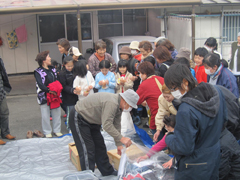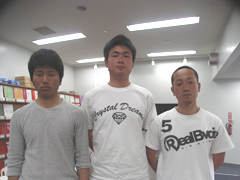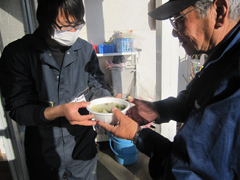Top>Hakumon CHUO [2011 Summer Issue]>[Campus Now Special edition] Facing the Great East Japan Earthquake "Is there anything we can do?"-Chuo students seriously facing up to the disaster / Yacht team sends 2 support teams to disaster area "You can't turn a blind eye"- Exhibiting seamanship
 Index
Index
[Campus Now Special edition] Facing the Great East Japan Earthquake
"Is there anything we can do?"-Chuo students seriously facing up to the disaster
Yacht team sends 2 support teams to disaster area
"You can't turn a blind eye"- Exhibiting seamanship
The yacht team sent two relief squads to the disaster area of the Great East Japan Earthquake and conducted activities such as delivering commodities, clearing rubble and delivering rice to evacuation centers. 4th year student in the Faculty of Economics and captain Hiroshi Yamazaki's (graduate of Miyako Shogyo High School, Iwate) home was damaged in the disaster, becoming a leading cause behind the support activities.
The captain's damaged home
When the huge temblor and tsunami devastated the whole East Japan region on March 11, Yamazaki, who was on a yacht club camp in Hayama Town, Kanagawa Prefecture, held great fears. "I didn't know if my parents were alive or not. My head was full of thoughts of what I should do. I wanted to confirm whether they were safe or not."
The other yacht club members were concerned about Yamazaki. 3rd year student in the Faculty of Letters, Taishi Kawakubo (graduate of Zushi Kaisei High School, Kanagawa) told us "We wanted to support our captain whose house was damaged. While watching the television images we thought that we had to do something."
Among all the club members at the camp who carried the strong feeling of, "I want to do something, but I don't know what I can do," it was Coach Kenichiro Ono who came up with the suggestion, "Let's check the road conditions, and when cars are able to pass, let's go to the disaster area." The decision was quickly made on the night of the day the disaster struck.
After that, the club members searched for detailed road information to the disaster zone on the internet. There was conflicting information on the internet directly after the quake, but by choosing and linking roads that were accessible by car, a route that went from Kanagawa through Niigata and making a big detour along the Japan Sea coast to Akita and into Iwate was decided upon.
Delivering emergency supplies to Yamada Town, Iwate Prefecture

Victims smiling at receiving emergency supplies (Offered by the yacht club)
In order to confirm the safety of Yamazaki's parents, four people, including Yamazaki and Kawakubo, filled up a van with as many emergency supplies as possible and left the camp at 8am on March 14. After practically one whole day, they arrived at Yamazaki's hometown of Yamada Town in Iwate Prefecture at 10am on March 15.
"My parents were safe but the mountains were still burning. There were dead bodies, too," said a stunned Yamazaki.
They immediately delivered the food, water, gas cookers, futons, clothes and toilet paper etc. that they had put into the van to the affected people in the area. At that time, the club members were asked by victims if they could also take the gasoline tank which was to be used for the trip back. Kawakubo knew of the gasoline shortage in the disaster region but had to regrettably decline by saying, "We won't be able to get home if we do that."
Yamazaki remained at his home and the yacht club members, who returned to the camp in Hayama Town, went straight to work in preparing a second disaster team. Those who saw the situation with their own eyes had a strong feeling that, "we should send a second team."
Cooperation from the Hayama Town locals
The yacht club traditionally holds its training camp in Hayama Abuzuri, and takes part in activities to fit into the community such as festivals and events. When the townspeople knew of the second relief team being sent to the disaster area, out of the blue they held a bazaar and gathered donations and relief supplies. "I think they cooperated because we were giving supplies directly to the victims, "said Kawakubo.
The second relief team left the lodgings in three cars on the morning of April 11 with supplies such as clothing, drinking water and children's toys, and arrived at Yamazaki's home in Yamada Town in Iwate late that night. The next day, the 12th, they headed to Kamaishi City, hometown of former yacht team member Jo Shimogawara.

Support team members. From left: Yuta Suzuki, Hiroshi Yamazaki and Taishi Kawakubo.
Jo lives in Funabashi, Chiba Prefecture, but his 104 year old grandfather, Takashi and parents perished together in his hometown. There was damage up to the second floor of Shimogawara's house in the giant tsunami. The team members helped by removing seawater-soaked tatami mats, sludge and debris, and cleaning up household goods and furniture.
At the end, they received these words from Jo, their senior, "Thanks. You really helped." Looking back at that time, both Yamazaki and Kawakubo stressed the strength of bonds between graduates and friends, "The yacht club is always getting support from the old boys. If our seniors or friends are in trouble, we will do anything we can to help."
After that, until the 14th, the relief team went around evacuation centers and graduates' homes in Yamada Town and Miyako in Iwate, and Kesennuma in Miyagi, delivering supplies. In Miyako they helped raise fishing boats in the harbour.
In three locations in Yamada Town, they cooked noodle soup in a large pot they borrowed from the Abuzuri community group, feeding about 300 people in total. "Large evacuation centers had rice, so we did it at the centers that didn't. It was good to have people pleased with our efforts at those places," said Yamazaki.
Changing their way of thinking through support activities

Hot noodle soup (Offered by the yacht club)
On the afternoon of the 15th, Yamazaki returned to the camp and relayed messages of gratitude from the victims to the Abuzuri community group and thanked the town for their cooperation.
Through the support activities, Kawakubo strongly felt, "After seeing the horror of natural disasters, I realized that this is real life and not something that happens to other people." Second year student in the Faculty of Letters, Yuta Suzuki (graduate of Sagara High School, Shizuoka), who participated in the second relief team noticed that he had changed within him, "I stopped having thoughts of sympathy for the victims and started to think how I could solve the problems."
Yamazaki said, "Through this experience, I learnt to put all my efforts into what is in front of me." And he added strongly, "It has a serious bearing upon life or death on the sea. If some is in trouble during a yacht race, you help them. You can't turn a blind eye." The source of the activities of the relief teams in the disaster area was seamanship.
(Student reporter Saki Watanabe, 2nd year student in the Faculty of Law)
- Research Activities as a Member of Research Fellowship for Young Scientists (DC1), Japan Society for the Promotion of Science (JSPS) Shuma Tsurumi
- Important Factors for Innovation in Payment Services Nobuhiko Sugiura
- Beyond the Concepts of Fellow Citizens and Foreigners— To Achieve SDGs Goal 10 “Reduce Inequality Within and Among Countries” Rika Lee
- Diary of Struggles in Cambodia Fumie Fukuoka
- How Can We Measure Learning Ability?
—Analysis of a Competency Self-Assessment Questionnaire— Yu Saito / Yoko Neha - The Making of the Movie Kirakira Megane








